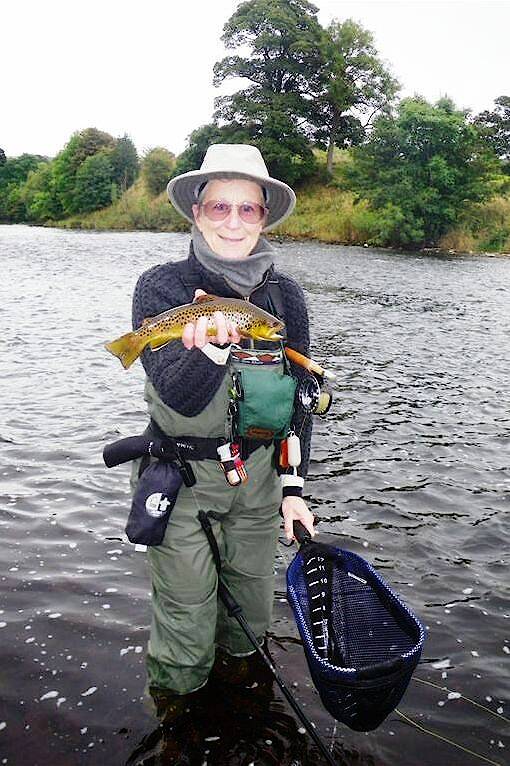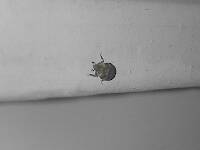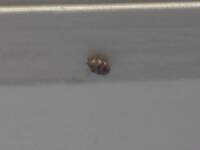
Hex Mayflies
Hexagenia limbata
The famous nocturnal Hex hatch of the Midwest (and a few other lucky locations) stirs to the surface mythically large brown trout that only touch streamers for the rest of the year.
Featured on the forum

This wild-looking little thing completely puzzled me. At first I was thinking beetle or month larva, until I got a look at the pictures on the computer screen. I made a couple of incorrect guesses before entomologist Greg Courtney pointed me in the right direction with Psychodidae. He suggested a possible genus of Thornburghiella, but could not rule out some other members of the tribe Pericomini.

Troutnut is a project started in 2003 by salmonid ecologist Jason "Troutnut" Neuswanger to help anglers and
fly tyers unabashedly embrace the entomological side of the sport. Learn more about Troutnut or
support the project for an enhanced experience here.
CaseyP on Jul 22, 2009July 22nd, 2009, 3:21 pm EDT
bug guys:
what color are the wings on a small black caddis, 16 or 18, on the Big Horn River, Montana? i'm guessing dark brown with speckles, but i have some dyed black elk hair if that's better.
i'm tying for our trip next week.
what color are the wings on a small black caddis, 16 or 18, on the Big Horn River, Montana? i'm guessing dark brown with speckles, but i have some dyed black elk hair if that's better.
i'm tying for our trip next week.
"You can observe a lot by watching." Yogi Berra
GONZO on Jul 23, 2009July 23rd, 2009, 5:10 am EDT
Casey,
I'm reasonably sure that the caddisflies that create the activity on the Big Horn at this time of year are Brachycentrus (aka Grannoms). The timing suggests that B. americanus is likely, although the lesser-known B. echo might be another possibility.
Although B. americanus often has some maculation on the wing (lighter flecks, especially around the apex), most of the information found in Big Horn hatch charts is limited to the vague "black caddis" description. I would suggest tying some dark Elk-Hair Caddis patterns to imitate active adults. I think I would lean toward using dark natural hair rather than black dyed hair, but I'm not sure it will make much of a difference. A clump of white/bright hair added on top of the dark elk-hair (or deer-hair) wing can be used to enhance visibility. You could also tie some flush-floating CDC styles for spent adults, or just trim (or omit) the hackle on the Elk-Hair style for a flush float. You might also consider adding a bright green butt to those flies, for both imitative (egg sac) and attractive ("hot spot") value.
Knowing that you are a fan of the classic English-style wets, I would also suggest tying soft-hackle styles to imitate emerging pupae or submerged adults. These could be along the lines of the Peacock and Starling (peacock herl body with a blackish hackle) or Grouse and Green (dull green body with a dark grouse or partridge hackle). You might consider adding a Krystal Flash rib on the Grouse and Green version.
I'm reasonably sure that the caddisflies that create the activity on the Big Horn at this time of year are Brachycentrus (aka Grannoms). The timing suggests that B. americanus is likely, although the lesser-known B. echo might be another possibility.
Although B. americanus often has some maculation on the wing (lighter flecks, especially around the apex), most of the information found in Big Horn hatch charts is limited to the vague "black caddis" description. I would suggest tying some dark Elk-Hair Caddis patterns to imitate active adults. I think I would lean toward using dark natural hair rather than black dyed hair, but I'm not sure it will make much of a difference. A clump of white/bright hair added on top of the dark elk-hair (or deer-hair) wing can be used to enhance visibility. You could also tie some flush-floating CDC styles for spent adults, or just trim (or omit) the hackle on the Elk-Hair style for a flush float. You might also consider adding a bright green butt to those flies, for both imitative (egg sac) and attractive ("hot spot") value.
Knowing that you are a fan of the classic English-style wets, I would also suggest tying soft-hackle styles to imitate emerging pupae or submerged adults. These could be along the lines of the Peacock and Starling (peacock herl body with a blackish hackle) or Grouse and Green (dull green body with a dark grouse or partridge hackle). You might consider adding a Krystal Flash rib on the Grouse and Green version.
CaseyP on Jul 23, 2009July 23rd, 2009, 6:42 am EDT
thanks, Lloyd! off to the desk as i write...thanks for keeping it simple. yes, i desperately wanted to take some wets too. folks have no idea what a difference a wet fly makes!
"You can observe a lot by watching." Yogi Berra
Shawnny3 on Jul 23, 2009July 23rd, 2009, 1:27 pm EDT
You might consider adding a Krystal Flash rib on the Grouse and Green version.
Just couldn't recommend a classic without throwing a little synthetic in the English's faces, could you, Lloyd?
-Shawn
Jewelry-Quality Artistic Salmon Flies, by Shawn Davis
www.davisflydesigns.com
www.davisflydesigns.com
Creno on Jul 23, 2009July 23rd, 2009, 3:29 pm EDT
The little black caddis of Bighorn fame is Amiocentrus aspilus. Pretty rare every where but there. The wings are iridescent black - shiny blue-greeny black. Out here we say magpie black. If you hit it right the fishing should bring us lots of stories. While I hope I am wrong I think next week may be a little early. Be sure to tie some spent (that is like Gonzo's CDC and no hackles). Often the 10 fish fly catches more than the fresh one up there. They float low. And take lots of grasshoppers (some smaller sizes) and beetles.
GONZO on Jul 23, 2009July 23rd, 2009, 4:26 pm EDT
Thanks for the correction, Creno.
Sorry, Casey, I had the wrong brachycentrids. That black-dyed elk hair might be better after all, but the soft hackles should appropriate for Amiocentrus.
You're right, Shawn, I couldn't resist. However, the Grouse and Green is actually Scottish pattern, so any offense taken by the English would be misplaced.
Sorry, Casey, I had the wrong brachycentrids. That black-dyed elk hair might be better after all, but the soft hackles should appropriate for Amiocentrus.
Just couldn't recommend a classic without throwing a little synthetic in the English's faces, could you, Lloyd?
You're right, Shawn, I couldn't resist. However, the Grouse and Green is actually Scottish pattern, so any offense taken by the English would be misplaced.
CaseyP on Jul 24, 2009July 24th, 2009, 7:51 am EDT
guys,
the dyed elk is rather coarse for the 18 hooks. the elk hock is better. guess i'll try coloring that, as well as using some black deer hair. our guide calls the hackle-less elk hair caddis "canoe" flies. do i put the CDC under the elk for the spent ones, or just tie CDC like elk hair??
there isn't much hackle on mine any more since i saw a caddis in the wild and noticed it doesn't have a centipede's worth of feet. does the original pattern have all that hackle to make it skitter on the surface?
we won't actually reach the water until the end of next week, and then might have a chance again at the end of the following week. hope the bugs co-operate. oh, yeah, grasshoppers galore--wish i could tie one. beetles are my middle name at this point, especially with iridescent under-wings. any size ideas for the beetles?
the dyed elk is rather coarse for the 18 hooks. the elk hock is better. guess i'll try coloring that, as well as using some black deer hair. our guide calls the hackle-less elk hair caddis "canoe" flies. do i put the CDC under the elk for the spent ones, or just tie CDC like elk hair??
there isn't much hackle on mine any more since i saw a caddis in the wild and noticed it doesn't have a centipede's worth of feet. does the original pattern have all that hackle to make it skitter on the surface?
we won't actually reach the water until the end of next week, and then might have a chance again at the end of the following week. hope the bugs co-operate. oh, yeah, grasshoppers galore--wish i could tie one. beetles are my middle name at this point, especially with iridescent under-wings. any size ideas for the beetles?
"You can observe a lot by watching." Yogi Berra
Martinlf on Jul 24, 2009July 24th, 2009, 1:18 pm EDT
Casey, here's how I tie my CDC caddis. You can omit the shuck if you want.
This caddis is easy to tie with a little practice, and it has taken some very picky, hard-pressured fish. I give a lot of detail in the directions that many will not need, but if you’ve never worked with CDC it may save you some headaches.
Tie in a short sparse ginger antron or z-lon shuck, dub the body with an appropriate color for the abdomen. Leave an eye length or two of the hook bare just behind the eye for tying in the CDC. Select three or four CDC feathers (three for 16 or 18 flies), hold each by the tip and stroke the fibers out perpendicular to the shaft, then stack them on top of each other, keeping the curves of the feathers the same so they will nest right on top of each other. Then holding the feather ends with left thumb and forefinger, strip off fibers on one side with the right thumb and forefinger. Next find a way to turn the feathers over in your left hand, keeping them stacked and lined up. (Holding the stripped fibers between thumb and index finger, I make a Star Trek Vulcan split between the ring and index finger of my right hand, flip my left wrist over to flip over the feathers, slip the body end of the feather shaft in the split between my ring and index fingers, clamp down, and let go with my left thumb and forefinger. Then I turn my left hand over to regrasp the stacked feathers which are now upside down and in the same position the feather barbs were when I did the first strip.) Then, carefully raise the right thumb, making sure the stripped fibers stay down on the right forefinger with gravity’s help. Move your left hand to lay the fibers on the unstripped stack right down on the stripped fibers, tips to tips, butts to butts, with the shaft of the feathers right over the stripped butts. The better the butts line up from the stripped and unstripped barbs makes all the difference. Grasp the tips of all the fibers with your right thumb and forefinger and strip CDC fibers off the other side of the stacked feathers. Roll the thumb and forefinger of the right hand away from the butts of the stripped fibers and grasp the butts with the left thumb and forefinger to gather them together. This takes some practice, and results in a few messes before you develop a way of doing it, but you should ideally end up with a nice bunch of CDC, with butts all together. Repeat several times to work the fibers into a “paintbrush” of CDC with all the butts together. Then pinch tie this bunch, butts forward over the eye, tying down just behind the eye with a couple of turns of thread. Then lift the butts and lay down some wraps back right against the first couple of tie down wraps to bind the wing in tightly sandwiching the CDC fibers between the initial wraps over them and the next ones under coming back. Next, whip finish under the wing butt fibers just behind the eye and trim the butts to expose the hook eye. Cut carefully to avoid cutting the thread. A tiny drop of superglue on the butts makes the fly bombproof, though I rarely use it except when tying flies for other folks. Then angle your scissors to cut the CDC tips forming the end of the wing at a slant, to imitate a caddis wing shape, cutting the wing about even with the end of the shuck, leaving the wing a bit longer than the hook.
This caddis is easy to tie with a little practice, and it has taken some very picky, hard-pressured fish. I give a lot of detail in the directions that many will not need, but if you’ve never worked with CDC it may save you some headaches.
Tie in a short sparse ginger antron or z-lon shuck, dub the body with an appropriate color for the abdomen. Leave an eye length or two of the hook bare just behind the eye for tying in the CDC. Select three or four CDC feathers (three for 16 or 18 flies), hold each by the tip and stroke the fibers out perpendicular to the shaft, then stack them on top of each other, keeping the curves of the feathers the same so they will nest right on top of each other. Then holding the feather ends with left thumb and forefinger, strip off fibers on one side with the right thumb and forefinger. Next find a way to turn the feathers over in your left hand, keeping them stacked and lined up. (Holding the stripped fibers between thumb and index finger, I make a Star Trek Vulcan split between the ring and index finger of my right hand, flip my left wrist over to flip over the feathers, slip the body end of the feather shaft in the split between my ring and index fingers, clamp down, and let go with my left thumb and forefinger. Then I turn my left hand over to regrasp the stacked feathers which are now upside down and in the same position the feather barbs were when I did the first strip.) Then, carefully raise the right thumb, making sure the stripped fibers stay down on the right forefinger with gravity’s help. Move your left hand to lay the fibers on the unstripped stack right down on the stripped fibers, tips to tips, butts to butts, with the shaft of the feathers right over the stripped butts. The better the butts line up from the stripped and unstripped barbs makes all the difference. Grasp the tips of all the fibers with your right thumb and forefinger and strip CDC fibers off the other side of the stacked feathers. Roll the thumb and forefinger of the right hand away from the butts of the stripped fibers and grasp the butts with the left thumb and forefinger to gather them together. This takes some practice, and results in a few messes before you develop a way of doing it, but you should ideally end up with a nice bunch of CDC, with butts all together. Repeat several times to work the fibers into a “paintbrush” of CDC with all the butts together. Then pinch tie this bunch, butts forward over the eye, tying down just behind the eye with a couple of turns of thread. Then lift the butts and lay down some wraps back right against the first couple of tie down wraps to bind the wing in tightly sandwiching the CDC fibers between the initial wraps over them and the next ones under coming back. Next, whip finish under the wing butt fibers just behind the eye and trim the butts to expose the hook eye. Cut carefully to avoid cutting the thread. A tiny drop of superglue on the butts makes the fly bombproof, though I rarely use it except when tying flies for other folks. Then angle your scissors to cut the CDC tips forming the end of the wing at a slant, to imitate a caddis wing shape, cutting the wing about even with the end of the shuck, leaving the wing a bit longer than the hook.
"He spread them a yard and a half. 'And every one that got away is this big.'"
--Fred Chappell
--Fred Chappell
CaseyP on Jul 24, 2009July 24th, 2009, 3:55 pm EDT
Creno, thanks so much for the tips. in the box marked "little furry bits" i found some dyed deer belly that was gorgeously shiny with bluish lights, so now we have some dressy looking flies. they're going to be perfect at dusk when the water goes that steely color and black is the only thing that shows up; otherwise i'm going to have to figure out how to find them! i'll try some with a bit of pink or orange bucktail on top of the wing next.
Louis, thanks for the tutorial on CDC caddis. you posted that fly some time ago on a thread called Favorite Flies. (Found it! Nov-Dec 2006 and revived occasionally since.) all i could manage at the time were beetles, and try as i might, i could not understand what you intended. now it all makes some sense! and i own some of the feathers.
if Best Fishing Buddy makes good on his promise that the XM radio can bring me my baseball as we drive west, i'll try tying some of your caddis.
Louis, thanks for the tutorial on CDC caddis. you posted that fly some time ago on a thread called Favorite Flies. (Found it! Nov-Dec 2006 and revived occasionally since.) all i could manage at the time were beetles, and try as i might, i could not understand what you intended. now it all makes some sense! and i own some of the feathers.
if Best Fishing Buddy makes good on his promise that the XM radio can bring me my baseball as we drive west, i'll try tying some of your caddis.
"You can observe a lot by watching." Yogi Berra
CaseyP on Aug 1, 2009August 1st, 2009, 2:54 am EDT
Creno, it was awsome! we never saw a fish until very late in the day, which meant that those little black bugs showed up just fine against the steel water. the Big Horn fish are indeed bigger than elsewhere--if you need practice on how not to break one off, come on over. did manage to land one or two. for once, Best Fishing Buddy did most of the catching.
this may deserve it's own thread, but what do you do when nothing, nada, rien de rien, is moving? i don't mean switching flies or changing leaders, i mean the desperate, superstition-founded actions meant to tip the universe into a more co-operative track.
this may deserve it's own thread, but what do you do when nothing, nada, rien de rien, is moving? i don't mean switching flies or changing leaders, i mean the desperate, superstition-founded actions meant to tip the universe into a more co-operative track.
"You can observe a lot by watching." Yogi Berra
Creno on Aug 2, 2009August 2nd, 2009, 9:13 am EDT
Casey - glad there were a few critters around for ya. Can't help you much when nothing is rising. I never learned to fish with bobbers and sinkers. If the terrestrials don't work right next to the bank I sit on a rock and ..... Or chuck and duck with streamers which can be awesome in the fall on the Bighorn.
Martinlf on Aug 3, 2009August 3rd, 2009, 5:22 am EDT
Casey, I managed a nice midge sipper on a local spring creek yesterday. He refused all my midges, but, on about the fifth drift, crushed a little CDC tan caddis tied upside down (tied so it floats hook up). Did you have any luck tying the CDC caddis? If not let me know where my directions weren't clear enough and I'll try again.
"He spread them a yard and a half. 'And every one that got away is this big.'"
--Fred Chappell
--Fred Chappell
Quick Reply
Related Discussions
Topic
Replies
Last Reply
4
Nov 1, 2012
by Entoman
by Entoman





